Amidst the COVID-19 pandemic, market volatility and fears of the next recession, here’s why you’re still better off putting your money in a DeFi portfolio.
Last year, we published a report that compared the returns from holding Ethereum and Bitcoin to holding DeFi assets on Compound, Uniswap and TokenSets. We found that Compound and Uniswap offer very attractive yield opportunities for investors holding stablecoins, and TokenSet’s ETH 20-Day MACO outperformed ETH buy-and-hold in returns while significantly reducing drawdowns. This time, we take a closer look at how DeFi has performed in the first quarter of 2020.

Over the past 6 months, the DeFi space has grown rapidly. 2020 began with a bang when the market cap of DeFi assets surpassed $1 billion – however, the excitement was short lived. In light of the Covid-19 pandemic and the subsequent economic downturn, both traditional and crypto markets have been dealt some heavy blows. DeFi has not been immune to the risk. The massive drop in Ethereum’s price a few weeks ago led to what is now known as “Crypto Black Thursday” and resulted in MakerDAO losing $4m+ in collateral. Many crypto investors are left wondering whether their assets can survive the current market volatility.
Does it still make sense to invest in DeFi?
The answer: a resounding yes. Right now, many investors are turning to asset-backed stablecoins to weather the storm. To test this, you can check out the stable.zerion.eth wallet which was created on 21 January 2020 with 0.6 ETH (about $100 at the time). 60% of the portfolio was put into stablecoin bets on Compound (DAI and USDC) and 40% of the portfolio was put into Uniswap liquidity pools. Liquidity pools allow investors to earn a yield on their holdings through trading fees and tend to soften losses and gains. Reduced exposure to ETH price combined with income from liquidity fees may therefore be an attractive strategy for conservative ETH holders looking to earn a return while reducing risk from falls in the price of ETH.
The first graph below shows an overview from 7 March to 7 April and the second graph zooms in on the past week (7 to 13 April):
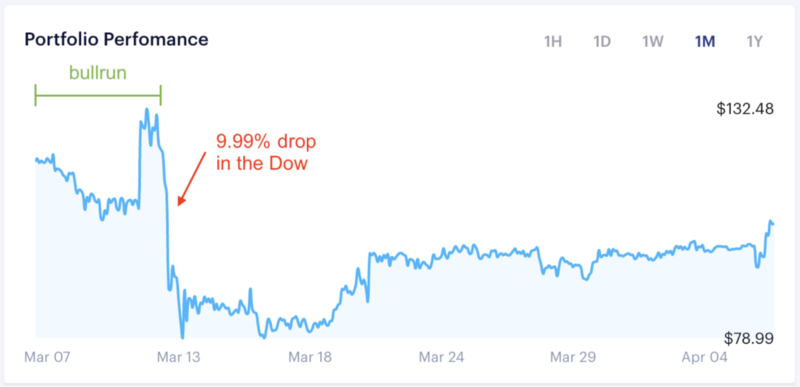
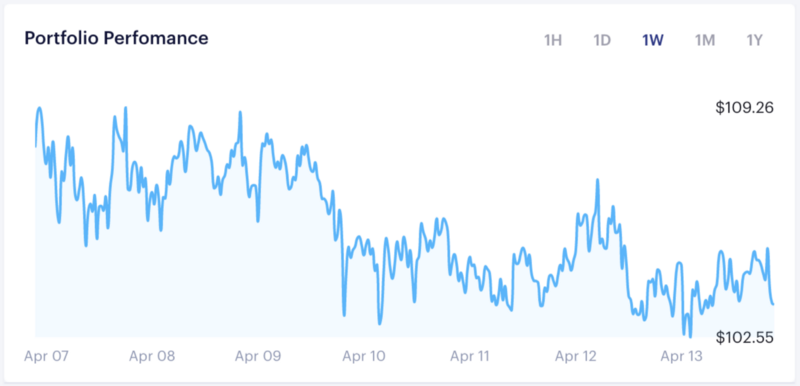
In February, the price of ETH shot up to a high of around $280, causing an increase in the value and trading activity of ETH liquidity pools. During this time, the value of the portfolio increased from $100 to $135. However, due to global fears of an economic meltdown brought on by the Coronavirus, the Dow dropped 9.99% on March 12th. Four days later on March 16th, the Dow made a record free fall of 12.93%. Crypto markets felt the impact, too. The portfolio lost most of its gains from the bull run and has now hovered consistently around the $100 mark.
Uniswap is a great tool to earn trading fees while maintaining your ETH exposure in case the market turns bullish. For investors who fear a price peak approaching but don’t want to risk selling too soon, liquidity pools like Uniswap’s ETH-DAI pair are an attractive option.
This ability to buffer market volatility in times of extreme uncertainty is a major advantage of investing in DeFi assets in general. Stablecoins are just one approach and offer short-term protection against risk. Below, we’ll take a look at the performance of a higher-value DeFi portfolio over a longer period.
DeFi returns for Q1 2020
For the first quarter of 2020, we analyzed the returns of:
- Lending DAI on Compound,
- Supplying liquidity to Uniswap’s DAI-ETH pool, and
- Investing in TokenSets’ ETH 20-Day and 50-Day Moving Average Crossover strategies.
We also present the returns for Ethereum and Bitcoin buy-and-hold strategies for the same period.
Note:
- We included additional dates up to April 13th to analyze performance during the Covid-19 pandemic.
- This analysis does not account for trading fees, slippage, or stablecoin price fluctuations.
Compound Returns
Compound is a lending protocol that allows users to pool assets which can then be borrowed after providing collateral. Interest rates are variable and dependent on supply and demand. Here is the performance of a 10,000 DAI portfolio and the annualized interest rates for each week:
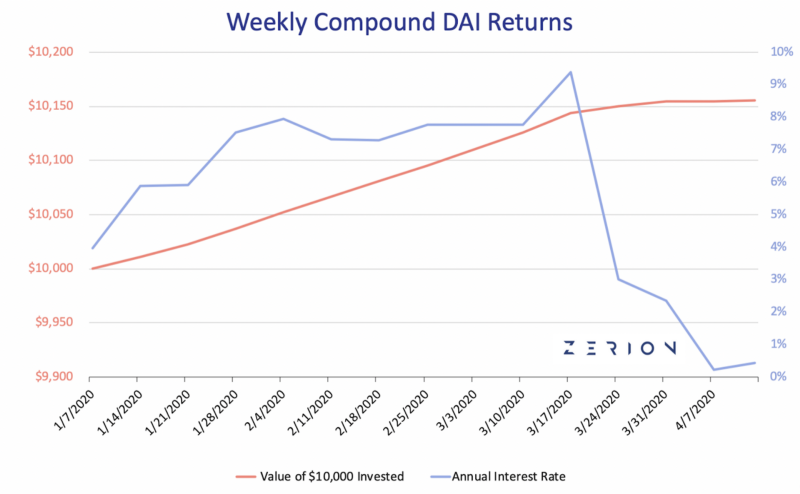
This graph only reflects weekly changes in the DAI lending rate. However, the month of March was extremely volatile. The lending rate peaked at 19.66% on March 12 — the same day the stock market crashed and ETH lost over 40% of its value — and by March 15th the lending rate stood at 3.99%. Despite this volatility in the lending rate, the portfolio returned a 1.56% yield on April 13.
Uniswap Pool Returns
Uniswap is an on-chain exchange that enables users to trade tokens with automated liquidity. Trades are matched from asset reserves supplied by liquidity providers, who can earn returns on trading fees. To learn more about investing in liquidity pools, check out our deepdive or our step-by-step tutorial.
Here are the returns for an investor who supplied $10,000 to a DAI-ETH pool on 1 January 2020 and stayed in the pool until 13 April 2020. In practice, this means that the investor supplied $5,000 worth of ETH and $5,000 worth of DAI into the pool. Over the period, the Uniswap DAI-ETH pool earned a 12.53% return.
In the figure below, the green columns show the weekly cumulative trading fees and the red columns show the weekly impermanent loss resulting from price volatility.
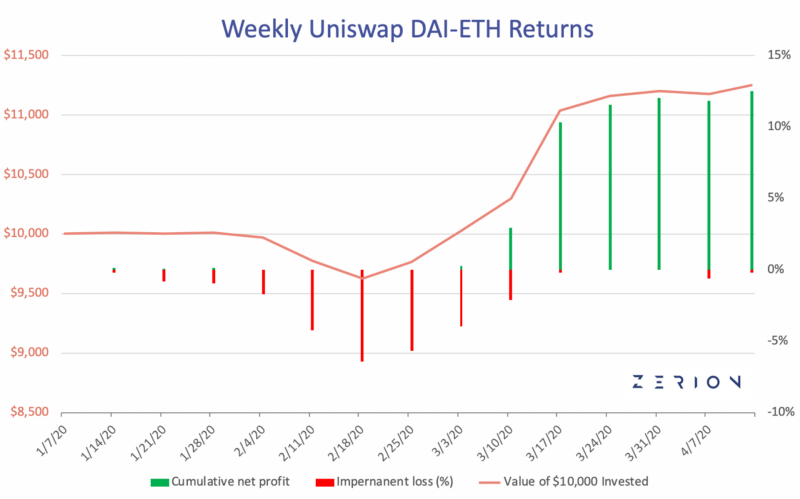
TokenSets: ETH 20-Day and 50-Day Moving Average Crossover Strategies
TokenSets are tokenized trading strategies where transactions are executed automatically without the user having to perform any actions.
We present the performance of two trending strategies: the 20-Day Moving Average Crossover (MACO) and 50-Day Moving Average Crossover. Both are simple momentum strategies aimed at capturing returns from persisting trends and rebalancing to cash when those trends reverse.
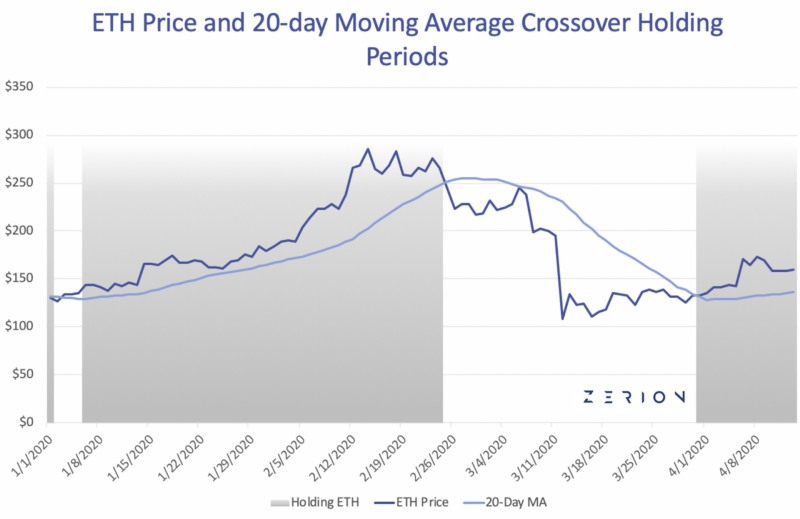
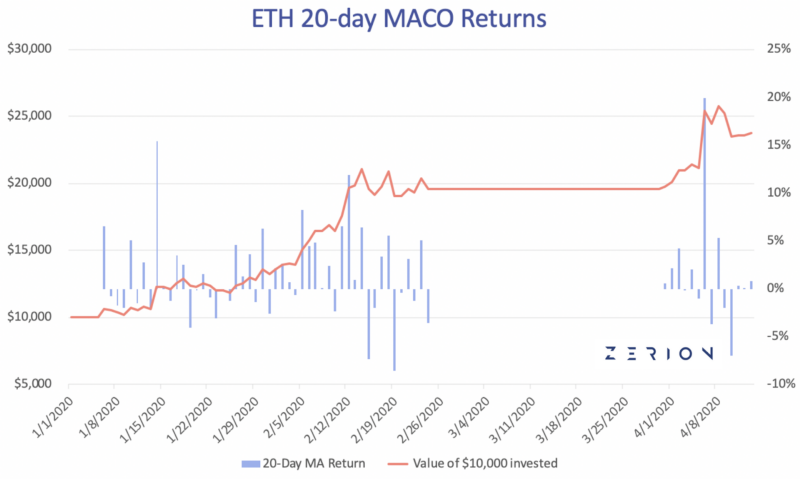
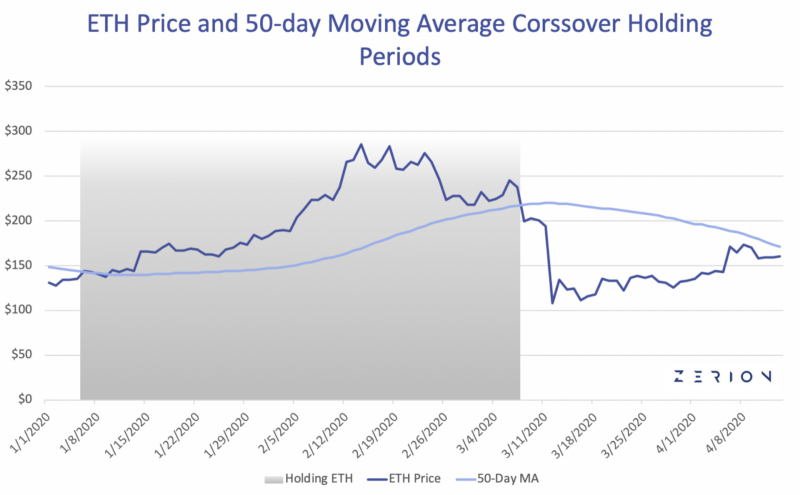
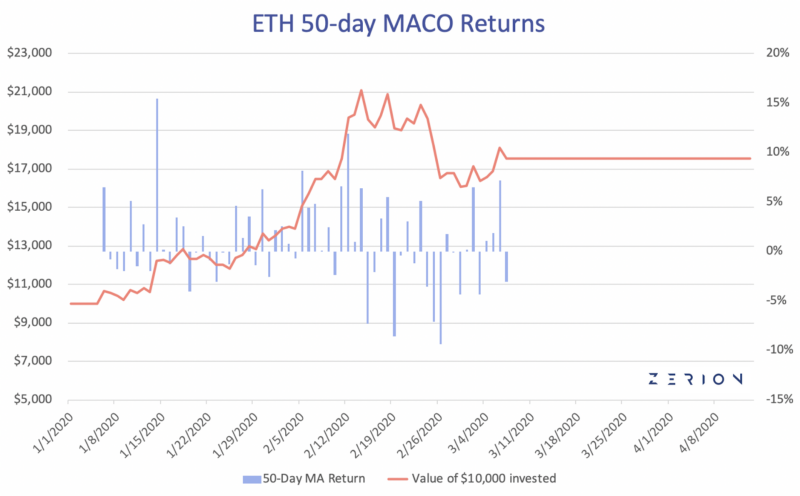
The moving average crossover strategy buys and holds ETH when the price of ETH is above the moving average, and sells ETH and holds stablecoins (specifically cUSDC) when the price is below the moving average. The rebalancing transactions occur on the day of a price crossover with the condition that 4 days have passed since the last rebalancing.
These two strategies are by far the most lucrative. The ETH 20-day MACO yielded a 137.63% increase while the ETH 50-day MACO yielded a 75.22% increase. In the first case the investor’s portfolio value would have grown to $23,763 and in the second case, $17,522.
Ethereum and Bitcoin Returns
Ethereum and Bitcoin remain highly correlated assets. However, Ethereum is starting to show more of a deviation as increased activity in the DeFi space increases demand for ETH.
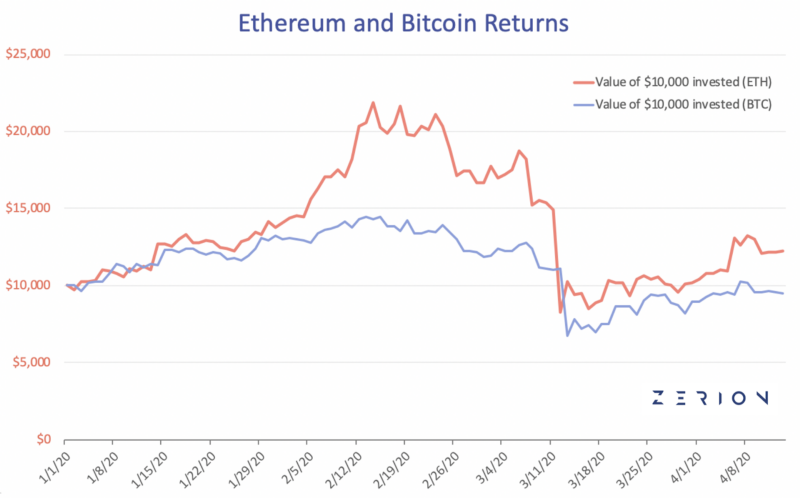
In our last report, we observed that both Ethereum and Bitcoin peaked at over 200% of their starting values. This time, Ethereum peaked at 118.83%, while Bitcoin did not cross above 44.64%. The drawdowns on each asset remain significantly worse than for the assets listed above — Ethereum’s lowest price resulted in a 17.38% decrease in portfolio value while Bitcoin dipped by 32.62%. At the end of the period, an Ethereum buy-and-hold strategy realized a 22.55% return and Bitcoin realized only 0.52%.
Summary
The evidence is pretty clear: investing in DeFi is a smarter way to manage your portfolio. Overall, automated trading strategies such as the ETH 20-Day MACO and ETH 50-Day MACO offered 137.63% and 75.22% returns respectively. Lending strategies on Compound and liquidity pools on Uniswap experienced drawdowns almost 20x lower than those experienced from holding ETH or BTC. In addition, as we’ve seen, stablecoin liquidity pools can be a lifeline in times of extreme uncertainty.

These results also say something broader about the evolution of the DeFi ecosystem. No market has been immune to the volatility that our world is now experiencing on all fronts – economic, political and social – but the safety net offered by assets designed to survive these conditions is promising. Volume on decentralized exchanges was already at its highest before volatility hit in March, and although volume has since decreased, it’s still above historical averages.
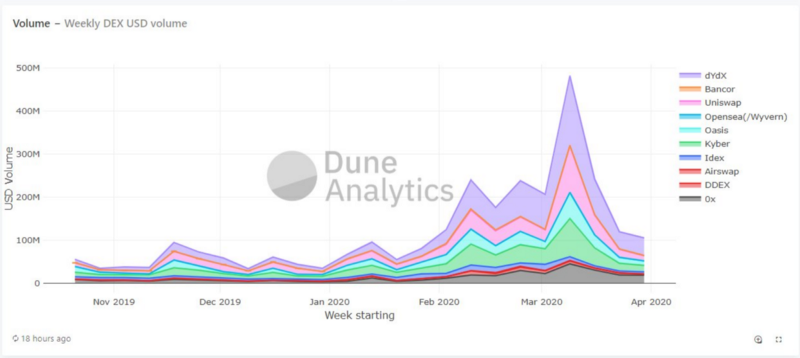
Zerion allows you to seamlessly track and manage your assets across DeFi protocols from one simple interface. Now, more than ever, it’s time to put your money to work.
This report is not investment advice.





